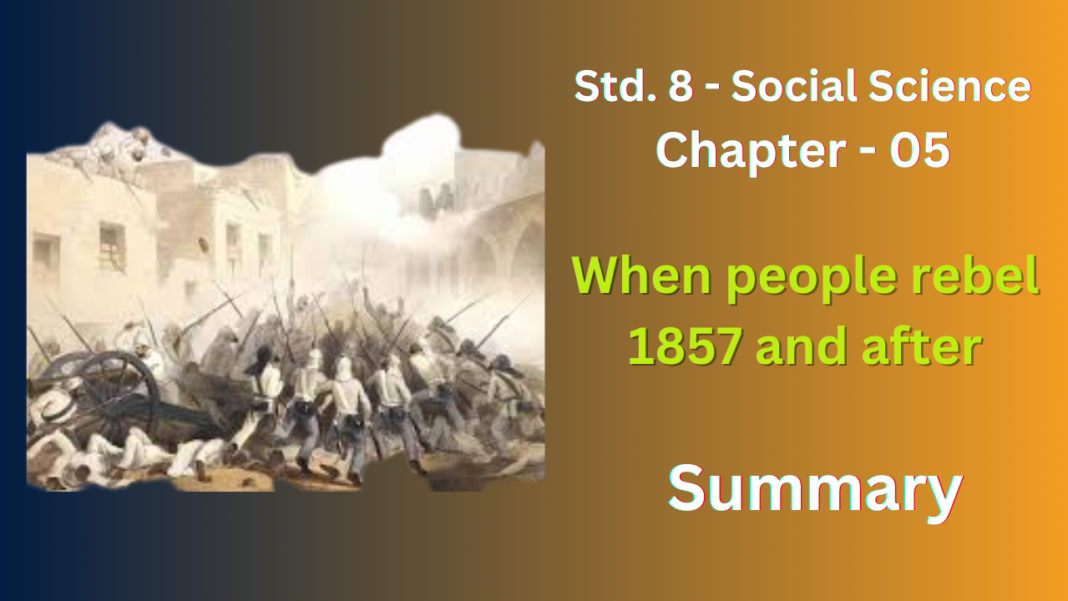NCERT Solutions for Class 8 History Chapter 5
The When people rebel 1857 and after chapter explores the growing resistance against British rule in India following the Sepoy Mutiny of 1857. Here’s a quick summary:
Seeds of Discontent:
- Sepoy Mutiny (1857): Though unsuccessful, the Sepoy Mutiny highlighted growing discontent among Indian soldiers with British policies and social reforms.
- Economic Exploitation: The British land revenue system and economic policies often burdened peasants and artisans, leading to hardship.
- Social and Cultural Disruption: British practices and missionary activities challenged traditional Indian society and religious beliefs, creating resentment.
Forms of Resistance:
- Peasant Revolts: Farmers rebelled against oppressive land revenue practices, like the Indigo Revolt in Bengal and Deccan revolts.
- Tribal Movements: Tribal communities resisted British control over their land and resources, with leaders like Birsa Munda emerging as symbols of defiance.
- Nationalist Movements: The late 19th and early 20th centuries saw the rise of organized national movements like the Indian National Congress, advocating for self-rule.
Impact and Significance:
- British Response: The British government implemented some reforms after the Sepoy Mutiny but continued to face resistance.
- Growth of Nationalism: These rebellions and movements fueled the growth of Indian nationalism, ultimately contributing to the fight for independence.
Overall, the chapter highlights the various forms of resistance against British rule in India after 1857. From peasant uprisings to tribal movements and the rise of nationalism, these struggles demonstrate the growing desire for self-governance and a rejection of colonial domination.
NCERT Solutions for Class 8 History Chapter 5
Exercise
1. What was the demand of Rani Lakshmibai of Jhansi that was refused by the British?
Ans : Rani Lakshmibai of Jhansi demanded that the British recognize her adopted son as the rightful heir to the throne of Jhansi after the death of her husband.
The British refused this demand due to the Doctrine of Lapse, a policy that allowed them to annex princely states if there was no male heir apparent through lineage. Rani Lakshmibai’s defiance and fight against the British annexation of Jhansi became a symbol of resistance against British rule in India.
2. What did the British do to protect the interests of those who converted to Christianity?
Ans : The British offered protection, funding for missionaries, social advantages, and inheritance rights to encourage Christianity in India, hoping to create a more favorable population for their rule. However, conversion rates remained low.
3. What objections did the sepoys have to the new cartridges that they were asked to use?
Ans : The sepoys’ objections to the new Enfield rifle cartridges stemmed from religious concerns. Here’s the breakdown:
- Religious Beliefs: Both Hindus and Muslims held beliefs about the purity of the mouth and avoiding contact with certain animal products.
- Cartridge Grease: It was rumored, and possibly true in some cases, that the new cartridges were greased with cow and/or pig fat. Biting off the paper end of the cartridge before loading (as required) would violate these religious restrictions.
- British Insensitivity: The sepoys felt the British disregarded their religious beliefs by introducing cartridges they couldn’t use without potentially compromising their faith.
This seemingly minor issue, the Enfield grease, became a spark that ignited wider discontent among the sepoys, ultimately contributing to the Sepoy Mutiny of 1857.
4. How did the last Mughal emperor live the last years of his life?
Ans : The last Mughal emperor, Bahadur Shah Zafar, lived his final years in misery. After the Sepoy Mutiny:
- Put on trial and sentenced to life imprisonment.
- Exiled to harsh conditions in Rangoon (Yangon) with limited resources.
- Witnessed the execution of his sons.
- Died a broken man in exile in 1862, stripped of power and dignity.
5. What could be the reasons for the confidence of the British rulers about their position in India before May 1857?
Ans : The British felt invincible in India before 1857:
- Stronger Army: They believed their advanced military was unbeatable.
- Loyal Sepoys (Wrong!): They misjudged sepoy discontent with reforms and pay.
- Divided India: They exploited existing rivalries to weaken any united resistance.
- Economic Grip: India’s dependence on British trade made them think Indians wouldn’t rebel.
Their confidence crumbled with the Sepoy Mutiny.
6. What impact did Bahadur Shah Zafar’s support to the rebellion have on the people and the ruling families?
Ans : Bahadur Shah Zafar’s support for the Sepoy Mutiny of 1857 had a significant impact on both the people and the ruling families of India:
Impact on People:
- Boosted Morale: The public perception of the Mughal emperor siding with the rebellion boosted the morale of the sepoys and common people fighting against the British. It offered a sense of legitimacy to the rebellion and the possibility of a return to Mughal rule.
- Wider Uprising: Bahadur Shah’s proclamation calling for the overthrow of the British encouraged rebellions and uprisings across various regions in North and Central India.
Impact on Ruling Families:
- Rallying Point: The Mughal emperor’s involvement inspired many deposed or disgruntled Rajput and princely families to join the rebellion. They saw an opportunity to regain their lost power and autonomy under British rule.
- Increased Brutality: The British, fearing a widespread rebellion fueled by the emperor’s support, responded with extreme brutality. This included the capture, execution, and exile of many royal families, further consolidating British control.
However, it’s important to note:
- Bahadur Shah Zafar’s role was largely symbolic. He lacked the military power or resources to significantly influence the rebellion’s course.
- The rebellion ultimately failed, and the British held the emperor accountable, leading to his exile and the final demise of the Mughal dynasty.
7. How did the British succeed in securing the submission of the rebel landowners of Awadh?
Ans : The British employed a multi-pronged approach to subdue the rebellious landowners (Talukdars) of Awadh after 1857:
- Divide and Conquer: The British exploited existing divisions among the Talukdars. They offered rewards and promised to maintain traditional land rights for those who remained loyal, weakening the overall resistance.
- Selective Amnesty: While some Talukdars faced harsh punishments, the British offered amnesty to others who surrendered and pledged loyalty. This encouraged defection within the rebel ranks.
- Confiscation and Reform: The British confiscated lands from those deemed most rebellious. They also implemented land reforms aimed at weakening the power of the Talukdars and improving the situation for peasants.
- Military Power: Ultimately, British military might was a key factor. Faced with superior firepower and a determined British force, the Talukdars’ resistance crumbled.
8. In what ways did the British change their policies as a result of the rebellion of 1857?
Ans : The Sepoy Mutiny of 1857 shook the British Empire’s confidence in its hold on India. In response, they implemented several policy changes:
- Transfer of Power: The direct rule of the East India Company came to an end. The British government took control of India through the Government of India Act (1858), establishing a Viceroy to represent the Crown.
- Military Reforms: The British army composition changed. The proportion of Indian soldiers was reduced, and recruitment shifted towards areas considered more loyal, like Sikhs and Gurkhas. Additionally, they focused on improving communication and intelligence gathering within the sepoy ranks.
- Focus on Administration: The British invested more in building a stronger administrative infrastructure in India. This included establishing a civil service exam system to recruit qualified personnel directly, aiming for a more professional and centralized administration.
- Appeasement of Princely States: The British became more cautious in dealing with Princely States. They largely abandoned the Doctrine of Lapse, a policy that allowed them to annex kingdoms without a male heir. This aimed to prevent further discontent among the remaining princely rulers.
- Limited Social Reforms: While the earlier policy of aggressive social reform was seen as a trigger for the rebellion, the British didn’t completely abandon it. They continued to promote some reforms like discouraging widow burning, but with a more cautious approach.
9. Find out stories and songs remembered by people in your area or your family about San Satavan Ki Ladaai. What memories do people cherish about the great uprising?
Ans : In 1857, a spark ignited a rebellion in Meerut. Even the Mughal emperor, Bahadur Shah Zafar, lent his voice to the cause. The flames of defiance spread like wildfire across India, leaving countless British casualties in their wake. Thousands of Indians bravely sacrificed their lives in the fight for freedom. Though ultimately suppressed, the rebellion shook the very foundation of British rule in India, forcing them to make concessions to appease the restless population.
10. Find out more about Rani Lakshmibai of Jhansi. In what ways would she have been an unusual woman for her times?
Ans : Rani Lakshmibai of Jhansi was a true firebrand and a symbol of resistance in 19th century India. Here’s why she was such an unusual woman for her time:
- Warrior Queen: In a society where women were expected to play a domestic role, Rani Lakshmibai was a skilled military leader who fought valiantly against the British. Her training in swordsmanship, horse riding, and warfare was highly uncommon for women of her era.
- Refusal to Submit: She fiercely opposed the British attempt to annex Jhansi after her husband’s death. This defiance against colonial rule stood out at a time when many faced British dominance with resignation.
- Rallying Figure: Rani Lakshmibai inspired not just her own people but others across India. Her leadership and courage during the rebellion were a beacon of hope in the fight for independence.
NCERT Solutions for Class 8 History Chapter 5
FAQ’s
What are the key causes of the 1857 Revolt discussed in NCERT Solutions for Class 8 History Chapter 5?
The key causes of the 1857 Revolt include widespread discontent due to British policies, economic exploitation, military grievances, and the cultural and religious insensitivity of the British, as detailed in “When People Rebel 1857 and After.”
Who were the main leaders of the 1857 Revolt according to NCERT Solutions for Class 8 History Chapter 5?
Main leaders of the 1857 Revolt include Rani Lakshmibai, Bahadur Shah Zafar, Tantia Tope, and Nana Sahib, who played significant roles in mobilizing and leading the rebellion, as discussed in “When People Rebel 1857 and After.”
What was the significance of the 1857 Revolt as per NCERT Solutions for Class 8 History Chapter 5?
The 1857 Revolt was significant as it marked the first major resistance against British rule, leading to significant changes in colonial policies and the administration of India, as highlighted in “When People Rebel 1857 and After.”
How did the British respond to the 1857 Revolt according to NCERT Solutions for Class 8 History Chapter 5?
The British responded with brutal suppression, executions, and retributive measures, followed by significant administrative changes, including the end of the East India Company’s rule and the beginning of direct Crown rule, as explained in “When People Rebel 1857 and After.”
What were the immediate consequences of the 1857 Revolt discussed in NCERT Solutions for Class 8 History Chapter 5?
Immediate consequences included widespread destruction, changes in military recruitment, restructuring of the administration, and increased racial animosity between the British and Indians, as outlined in “When People Rebel 1857 and After.”
How did the 1857 Revolt influence future Indian independence movements according to NCERT Solutions for Class 8 History Chapter 5?
The 1857 Revolt influenced future independence movements by instilling a sense of unity and resistance among Indians and serving as a precursor to subsequent struggles for freedom, as discussed in “When People Rebel 1857 and After.”
What role did the Indian soldiers (sepoys) play in the 1857 Revolt as per NCERT Solutions for Class 8 History Chapter 5?
ndian soldiers, or sepoys, played a pivotal role in initiating the revolt due to grievances over conditions of service and cultural disrespect, leading to widespread military insurrections, as detailed in “When People Rebel 1857 and After.”
What were the social and cultural impacts of the 1857 Revolt mentioned in NCERT Solutions for Class 8 History Chapter 5?
The social and cultural impacts included heightened British suspicion and racial policies, suppression of traditional practices, and a strengthened resolve among Indians to preserve their cultural identity, as explained in “When People Rebel 1857 and After.”









